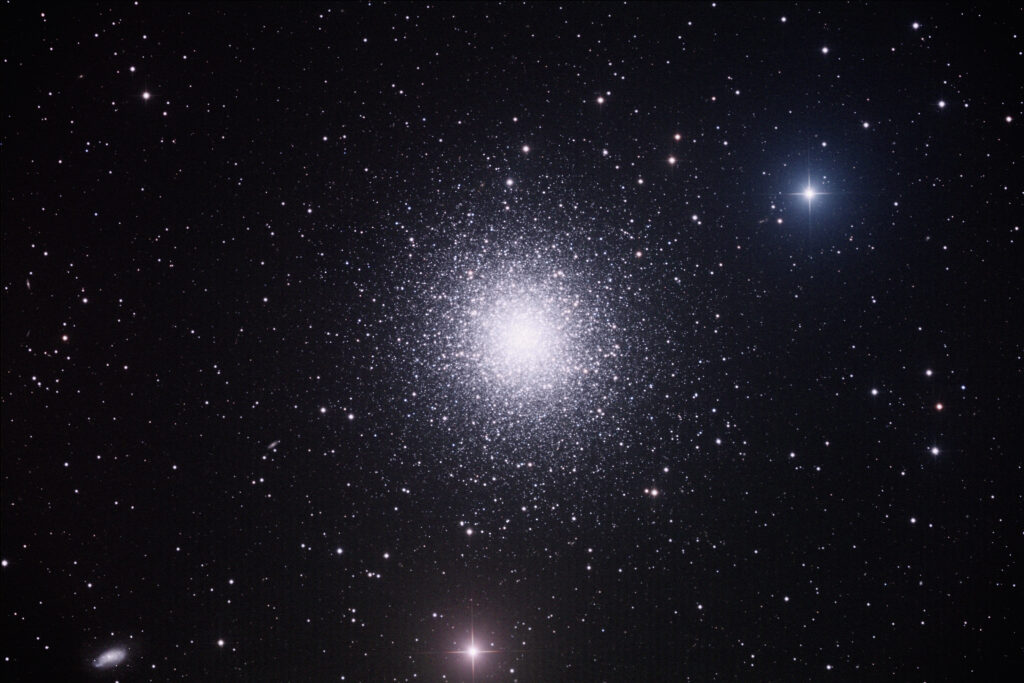Many stars within our galaxy exist in vast "star clusters." There are two main types--"open" and "globular." Open cluster are very diffuse associations of a few dozen to several hundred stars. Globular clusters are very dense, compact swarms of hundreds of thousands of stars. Thousands of open clusters have been identified in our galaxy, but only 147 globular clusters.
M13, the Hercules Star Cluster, is the most spectacular example of a globular star cluster visible from the northern hemisphere. The estimated population of M13 is one million stars. The stellar density increases towards the center, where a thousand stars are packed into each cubic light year (an average separation between stars of 0.1 light year). By comparison, the nearest star to Earth, beyond the Sun, is 4.2 light years away.
As dense as the core of this cluster appears, the likelihood of "hitting" a star by firing a rifle bullet through the center is about 1 in 100 billion. This is due to the great distances that separate the stars, even in the center, where the distances between stars would be comparable to thousands of basketballs separated from each other by 100 miles!
How would "night" appear on a planet in this cluster? Would the sky appear to be filled with bright stars like our Sun? Astronomers note that the average separation of stars, even in the core, is only 0.1 light years, or about 150 times the distance between the Sun and Pluto. Even at Pluto's distance, the Sun is a relatively small, unimpressive object in the sky, providing little illumination or warmth. If Pluto were 150 times farther from the Sun, the Sun would appear as little more than a bright star. So, even though thousands of cluster members could be seen from a planet in M13, the sky would be dark. Further, detailed images of globular cluster M15 taken by the Hubble Space Telescope in 1994 show 30,000 stars in the central 22 light years of the cluster. This would yield a stellar density (average distance between stars) of about 1.5 light years, or about a third of the distance from our Sun to the nearest known star, Proxima Centauri. Our Sun, if it were 1.5 light years away, would shine at a magnitude (brightness) of -1.9, or about the same brightness as the star Sirius, the brightest star in the sky from planet Earth (other than the Sun). So, from a planet near the center of this cluster, the sky would be filled with glittering, bright stars, but they would appear as bright stars, not as numerous "Suns." This assumes that the physical characteristics of M15 are comparable to M13.
On the other hand, some astronomers speculate that the stars in the core of M13 are so dense that collisions would occur, which explains the origin of hot, young blue stars ("blue stragglers") in an otherwise old cluster. Here is a quote from the NASA website, commenting on a Hubble Space Telescope image of the center of M13: "Like a whirl of shiny flakes sparkling in a snow globe, Hubble caught this glimpse of many hundreds of thousands of stars moving about in the globular cluster M13, one of the brightest and best-known globular clusters in the northern sky. . . . These stars are packed so closely together in a ball, approximately 150 light-years across, that they will spend their entire lives whirling around in the cluster. Near the core of this cluster, the density of stars is about a hundred times greater than the density in the neighborhood of our sun. These stars are so crowded that they can, at times, slam into each other and even form a new star, called a blue straggler."
Note the small galaxy, NGC6207, in the bottom left corner of this image. While it looks unimpressive compared to the brilliance of M13, this is only because it is millions of light years farther away. It is large spiral galaxy containing a hundred billion suns. Compare that to M13's population of a million suns, only 25,000 light years away in our Milky Way galaxy.
A powerful radio signal was beamed to this cluster by the giant radio telescope in Arecibo, Puerto Rico, in 1974. If anyone is listening, we can look forward to a response in 50,000 years.
The Hercules Star Cluster (M13)
Date Taken:April 25, 2014
Location Taken:New Mexico Skies Observatory
Conditions of Location: Equipment Used:Planewave 20" corrected Dall-Kirkham telescope, FLI PL11002M camera
Processing Used:8 x 3 minute exposures of luminance, red, green, and blue, processed in Maxim DL and Photoshop. Total exposure 1 hour 36 minutes.
Distance from Location:25,000 light years
Constellation:Hercules
Other Link:http://www.nasa.gov/multimedia/imagegallery/image_feature_1552.html

